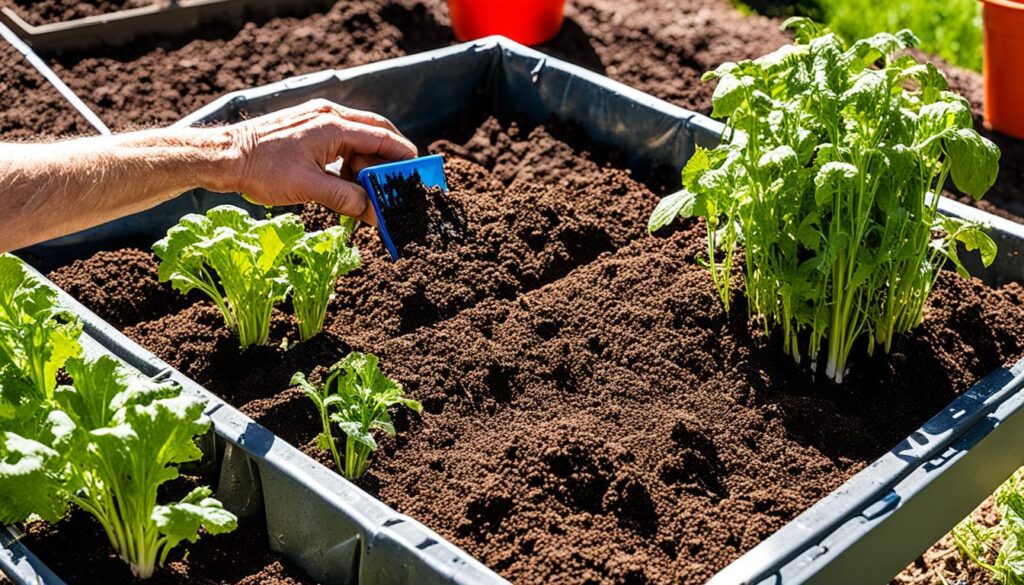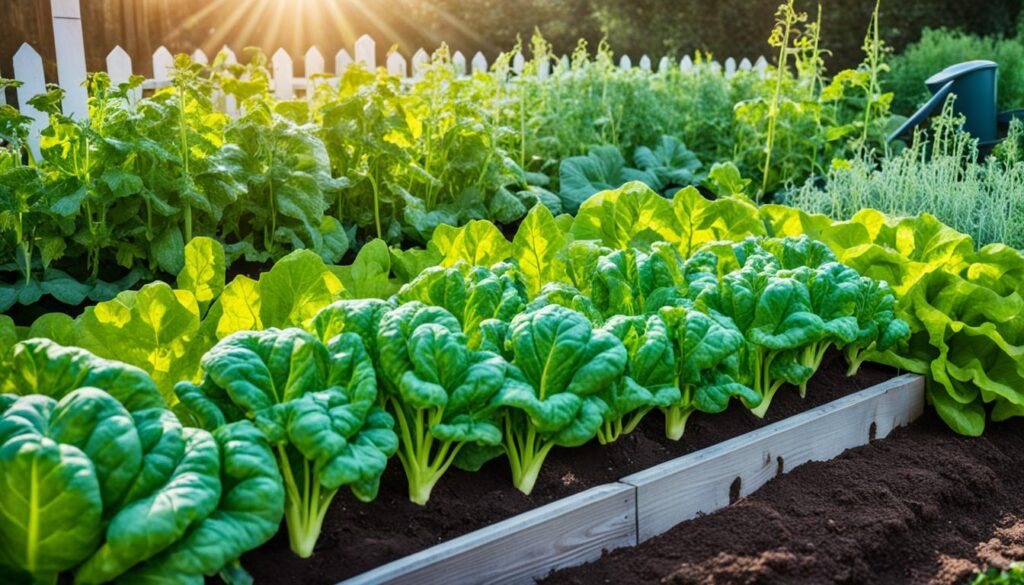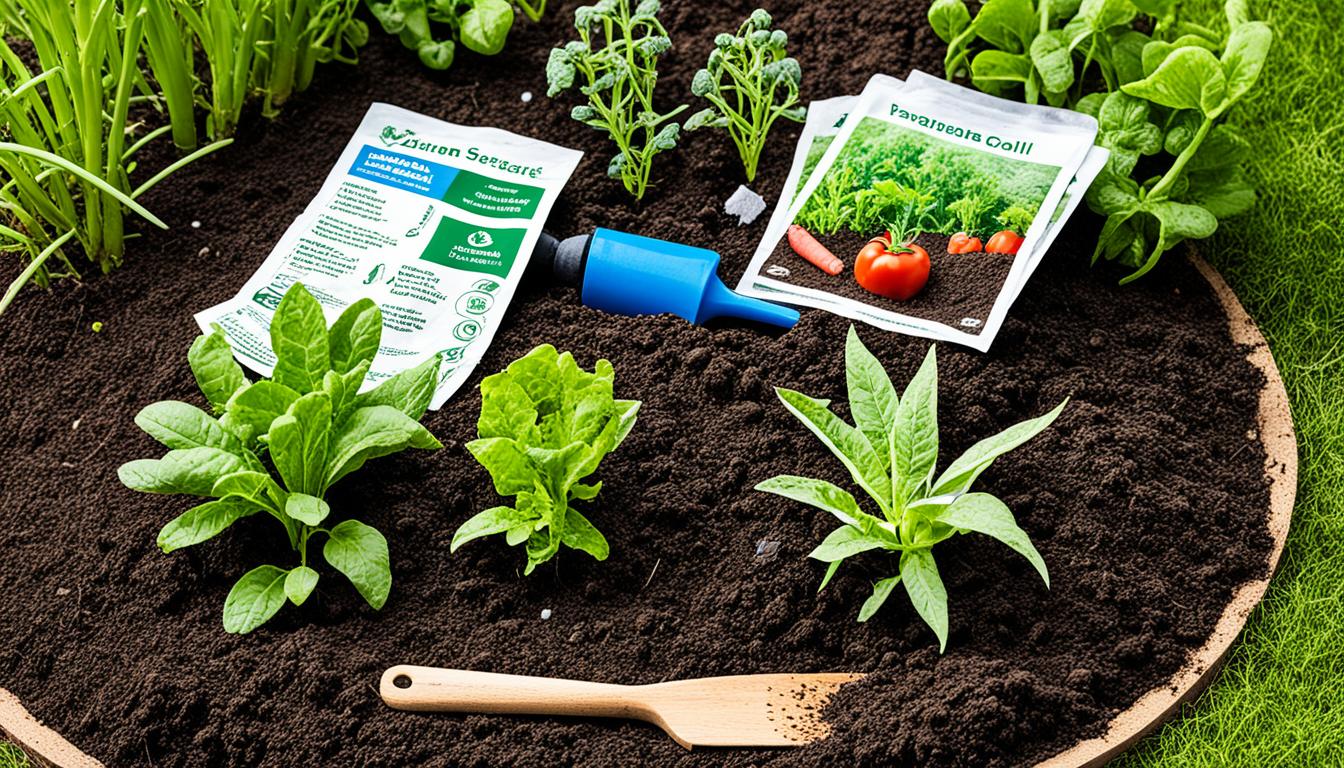Starting a vegetable garden needs a good plan. Choose a spot that gets plenty of sunlight.
Make sure the soil is ready and pick the best veggies to plant. This way, your garden will flourish.
Selecting a Garden Site
Choosing the right spot for your vegetable garden is key. The place where you grow your veggies really matters. You need to think about a few things before picking a spot.
Sunlight
Plants love sunlight, so pick a place that gets at least six hours each day. Sunlight means energy for plants to grow. Make sure your garden isn’t blocked by trees or buildings, or your veggies won’t do well.
Water Source and Drainage
Being close to water is also important since veggies need to stay hydrated. It’s best if there’s a water source not too far away. Also, check that the ground can drain well. Too much water around the plants can cause sickness. Good drainage is a must.
Estimating Space
Planning your garden layout before planting is a smart move. Measure the area and draw a layout. This helps you see how much space you have and decide what to plant where. Giving each plant enough room is crucial for their health.
When setting up your vegetable garden, look for a sunny spot close to water. Remember, good drainage is key too. Doing this sets up your garden for success.
Preparing the Soil
Before planting, get the soil ready for your garden. Good soil boosts your plant health and growth. Follow these steps to make your soil perfect for planting vegetables.
1. Loosen the Soil
Use a spading fork or shovel to turn the soil. This lets roots move freely and helps water soak in. Pull out grass, weeds, rocks, and debris to clear space for your plants.
2. Add Organic Matter
Add things like compost or manure to make the soil rich. This step makes the soil drain well and hold nutrients. It also stops too much water from running away. Put down 2 to 4-inch layer of this organic matter.
3. Mix in Fresh Garden Soil
Add fresh soil to the organic matter for more nutrients. This mix gives your plants what they need to grow strong. Keep 1 part organic matter to 2 parts of garden soil for best results.
Image: Adding Organic Matter to Soil
That’s it! Your soil is now set for a great vegetable garden. The added organic matter will feed your plants and keep the moisture right. This is the healthy base your plants need to thrive.
Remember, the way you prepare soil can change based on where you live and what your soil is like. A soil test or advice from a local expert can help you get the best plan for your garden.
| Benefits of Preparing the Soil | How to Achieve It |
|---|---|
| Enhances soil fertility | Add organic matter such as compost or well-rotted manure |
| Improves soil structure and drainage | Loosen the soil with a spading fork or shovel |
| Increases moisture retention | Mix in fresh garden soil to provide necessary nutrients |
| Promotes healthy root development | Remove grass, weeds, rocks, or debris |
Choosing Vegetables for the Garden
When starting a vegetable garden, picking the right veggies is crucial. Consider what you like to eat, your area’s seasons, and what grows best locally.
Follow these simple steps to pick the right vegetables:
- Choose vegetables you enjoy: It’s best to grow what you love to eat. This way, you get to taste the fruits of your labor.
- Consider the growing season: Look into what plants do well in your area’s climate. This ensures your garden thrives.
- Start with easy-to-grow varieties: Beginners should begin with simple plants. Try tomatoes, lettuce, beans, and cucumber for an easy start.
- Allocate enough space: Don’t forget, each plant needs room to grow. Crowded plants don’t grow as well and can get sick more easily.
- Provide proper care: Each plant has different needs. Think about sunlight, water, and what the soil should be like. Make sure to give them what they need.
By selecting the right vegetables and caring for them properly, you can have a great harvest. Growing your own food brings a sense of pride and the joy of eating fresh from the garden!
| Season | Recommended Vegetables |
|---|---|
| Spring | Peas, spinach, lettuce, carrots |
| Summer | Tomatoes, cucumbers, peppers, zucchini |
| Fall | Broccoli, kale, onions, beets |
| Year-round | Herbs (such as basil, parsley, and mint), Swiss chard, radishes |
Planting Your Vegetable Garden: Step-by-Step
Now that you’ve found the best spot and prepped the soil, let’s start planting. We’ll walk through each step to help you grow a great garden.
1. Digging Holes
When you plant, make sure the holes are big enough for the roots. This lets the plants grow well. Always leave enough space between plants. Look at the plant tags or seed packets for the right distance.
2. Sunlight and Air Circulation
Vegetable gardens need lots of sun and fresh air. Most plants need six hours of sun daily. Good air flow helps plants stay healthy. Remember to leave space for plants to grow big.
3. Support for Tall-Growing Plants
Some plants, like tomatoes and beans, need help to stand tall. You can use sticks or trellis for this. Supporting plants also keeps the fruits from touching the ground. This stops them from rotting or being eaten by bugs.
4. Watering and Irrigation
Water your new garden well after planting. The soil should be damp but not soaked. Too much water can harm the plants. A drip system or soaker hose is a great way to water. It helps use water efficiently and your plants grow better.
5. The Importance of Mulching
Adding mulch around your plants is very helpful. Mulch keeps in moisture and stops weeds. It also keeps the soil a good temperature. Use things like straw or leaves. They help save water and make your plants healthier.
| Vegetable | Planting Depth | Spacing | Sunlight Requirements |
|---|---|---|---|
| Tomatoes | 6-8 inches | 24-36 inches | Full Sun |
| Lettuce | 1/4 inch | 8-12 inches | Partial Shade |
| Beans | 1-2 inches | 4-6 inches | Full Sun |
| Radishes | 1/2 inch | 1-2 inches | Full Sun |
| Cucumbers | 1 inch | 24-36 inches | Full Sun |

By following these simple steps, you can start a successful garden. Don’t forget to water, weed, and keep an eye out for pests. With a little patience and effort, you’ll soon enjoy the tasty rewards of your hard work!
Starting a Container Vegetable Garden
If you have limited space or don’t like traditional planting, try a container garden. It’s a great way to grow veggies without a yard. This method is perfect for those with little outdoor space or in apartments.
To start, follow these easy steps:
Step 1: Choose the Right Container
Pick a large container with drainage holes. For example, you could use a five-gallon bucket. Make sure it’s clean and safe for plants.
Step 2: Select the Right Soil
Use high-quality soil for your container. Never use regular garden soil. It can lack the needed drainage and nutrients.
Step 3: Choose the Right Vegetables
Choose veggies that do well in containers. Good choices include tomatoes, peppers, and herbs. Make sure they fit the size of your container.
Step 4: Provide Sunlight
Put your containers where they get six hours of sun daily. If this isn’t possible, use grow lights. This ensures your veggies grow well.
Step 5: Water Regularly
Keep your garden watered but not soaked. Containers dry out quickly, so check the soil often. Water needs vary based on the weather and plant types.
Container gardens let you grow your favorite veggies with little space. Care for your plants well, and you’ll have a great harvest.
Vegetable Garden Tips
Want a great vegetable garden? You’ll need some top tips for a big harvest. Let’s dive into some advice for your green space:
1. Stagger Your Planting Times
Keep your garden giving throughout the year by planting at different times. Manage this by putting a few seeds or seedlings in every couple of weeks. This way, you’ll always have fresh veggies to pick.
2. Nourish the Soil
Boost your soil with natural stuff like compost or manure. Doing this adds important nutrients for plants. Also, consider using organic fertilizers to up the nutrients even more.
3. Pest and Disease Control
Watch closely for pests or disease on your plants. Try handling these issues without harmful chemicals. You can pick bugs off by hand, use organic sprays, or plant flowers that insects don’t like nearby.
4. Protect Your Garden
Wild critters can be a real problem for your veggies. Put up fences or cover your garden with nets to keep them at bay. This stops animals like rabbits, squirrels, and birds from snacking on your plants.
5. Enhance Visual Appeal
Make your veggie patch look better by adding nice edging or flowers. It doesn’t just pretty things up. It also invites good bugs that help with pollination and pest control.
| Tips for Successful Vegetable Gardening |
|---|
| Stagger your planting times |
| Nourish the soil with organic matter and fertilizer |
| Control pests and diseases using safe methods |
| Protect your garden from wildlife |
| Add decorative edging or low-growing flowers |

Watering Your Vegetable Garden
Keeping your vegetable garden watered is key for its well-being. Here are important watering tips for your veggies:
Water Deeply
It’s essential to water your garden deeply. This lets water go down to the roots of your plants. If you water too shallowly, your plants won’t have deep roots. With shallow roots, they might struggle in dry times.
Aim to soak the soil deeply, about 6-8 inches, for strong root growth.
Avoid Over-Watering or Underwatering
Finding the right water balance is important. Too much water can harm your plants. It can make the soil too wet, leading to root problems. Yet, not enough water makes plants dry and stressed.
To know when to water, check the soil with your finger. If it’s dry up to your second knuckle, then it’s time. If it’s still moist, wait to water.
Water in the Late Afternoon or Early Evening
Choosing the correct time to water is crucial. The late afternoon or early evening is best. It lets the plants cool off and uses less water due to less sunshine.
Do not water when it’s hottest. The water might just disappear before helping your plants.
Use Techniques such as Soaker Hoses or Furrow Irrigation
Using methods that water your plants’ roots directly is smart. Soaker hoses work well by letting water seep into the soil slowly. This reduces the water that moves away and ensures roots get water deep down.
Furrow irrigation does a similar job. It’s where water is guided into channels between plants. This way, water goes directly where it’s needed.
Avoid Wetting the Leaves
Wetting your veggie leaves can lead to sickness, like fungal infections. To keep your plants healthy, water the soil around them. A drip system that waters the ground works great for this.
Following these steps will help your vegetable garden thrive. Your plants will get the right water and grow well.
Conclusion
Starting a vegetable garden is a great way to get fresh, healthy food at home. You can follow the guide in this article to have a successful garden. You’ll enjoy a lot of vegetables from your hard work.
Choose a spot with lots of sunlight and good drainage for your garden. Make sure it’s close to water. You should also plan how much space your veggies will need.
It’s vital to prepare the soil well. Use a spading fork to loosen it. Remove any weeds. Then, add compost or manure. This will make the soil better for your plants.
Think about what veggies you like and what grows well in your area. Good choices for beginners are tomatoes, lettuce, and cucumbers. Make sure each plant has enough room and the right care.
Now, you’re ready to plant. Put the plants in the ground and water them well at the start. Consider using a drip system to water them easily.
If you can’t have a big garden, try planting in containers. Use a large, draining container filled with soil. Pick vegetables that do well in containers. They need sun and water.
Keep your garden up by planting at different times and using natural fertilizers. Watch out for bugs and diseases. You can also make your garden look nice with pretty plants around it.
Watering correctly is very important. Water deeply, but not too often. It’s best done in the late afternoon. Soaker hoses help the plants without wetting their leaves.
In conclusion, starting a garden is about finding a good spot, readying the soil, choosing plants, and taking care of them. By doing these steps, you will enjoy growing your own healthy food. Have fun gardening!
Vegetable Gardening for Beginners
Vegetable gardening is a great hobby for anyone new to it. It’s rewarding and connects you with nature. You can do it in a backyard or on a small balcony. You’ll love eating what you grow.
It’s smart to start with easy vegetables like tomatoes, lettuce, or radishes. They’re simple to care for. You’ll feel great watching them grow.
Good light, soil, and water are key to gardening. Vegetables usually need 6 hours of sun a day. Pick a sunny place for your garden. Add compost to the soil to make it better. Don’t forget to water, especially when it’s hot.
Make a plan for your garden to use space well. Think about how big each plant will get. Give plants enough space so they grow well. Take care of your garden all season. Remove weeds, feed your plants, and protect them from pests.
Vegetable gardening is good for both new and experienced gardeners. You get to enjoy fresh food and the fruits of your labor. It’s a fun and worthwhile journey. So start gardening and enjoy the adventure.
FAQ
How do I select a garden site for my vegetable garden?
Pick a spot that gets six hours of sun each day. This area should be free of shade from trees. Check if it’s near water and has good drainage. Measure the space and make a plan before planting.
How do I prepare the soil for my vegetable garden?
First, use a spading fork or shovel to loosen the soil. Remove grass, weeds, rocks, and debris. Then, add compost or manure to make the soil better. Mixing in fresh soil will provide needed nutrients for your plants.
What vegetables should I choose for my garden?
Pick vegetables that you and your family like to eat. Think about your area’s growing season. Look for vegetable types that grow well where you live. Try easy plants like tomatoes, lettuce, beans, radishes, and cucumbers for a start. Make sure you have enough space and know how to care for each type of vegetable.
How do I plant my vegetable garden?
Plant your garden by digging holes for your plants. Make sure the holes are big enough. Space the plants well and give them plenty of sun and air. Use supports like stakes for tall plants. Water your plants and consider using a drip system for better watering.
Can I start a vegetable garden in containers?
Sure, you can garden in containers if space is an issue. Pick a big container with drainage. Fill it with soil and plant vegetables that do well in containers. Give the containers enough sunlight and water them regularly.
What are some tips for successful vegetable gardening?
To succeed, plant at different times to get veggies all season. Feed the soil with organic matter and fertilizers. Watch for pests and diseases. Keep animals away with fencing. Adding flowers can make your garden pretty.
How should I water my vegetable garden?
Water your garden right for healthy plants. Give them plenty, but don’t overdo it. Water in the late day to help them deal with the sun’s heat. Use methods like soaker hoses or furrows to water the roots directly. Do your best to keep the leaves dry to avoid diseases.
How do I start a vegetable garden as a beginner?
Being a beginner at gardening is a fun adventure. Start with simple vegetables. Keep in mind what they need for sun, soil, and water. Plan your garden well and care for it all season. Enjoy your homegrown veggies and the time with nature.


















